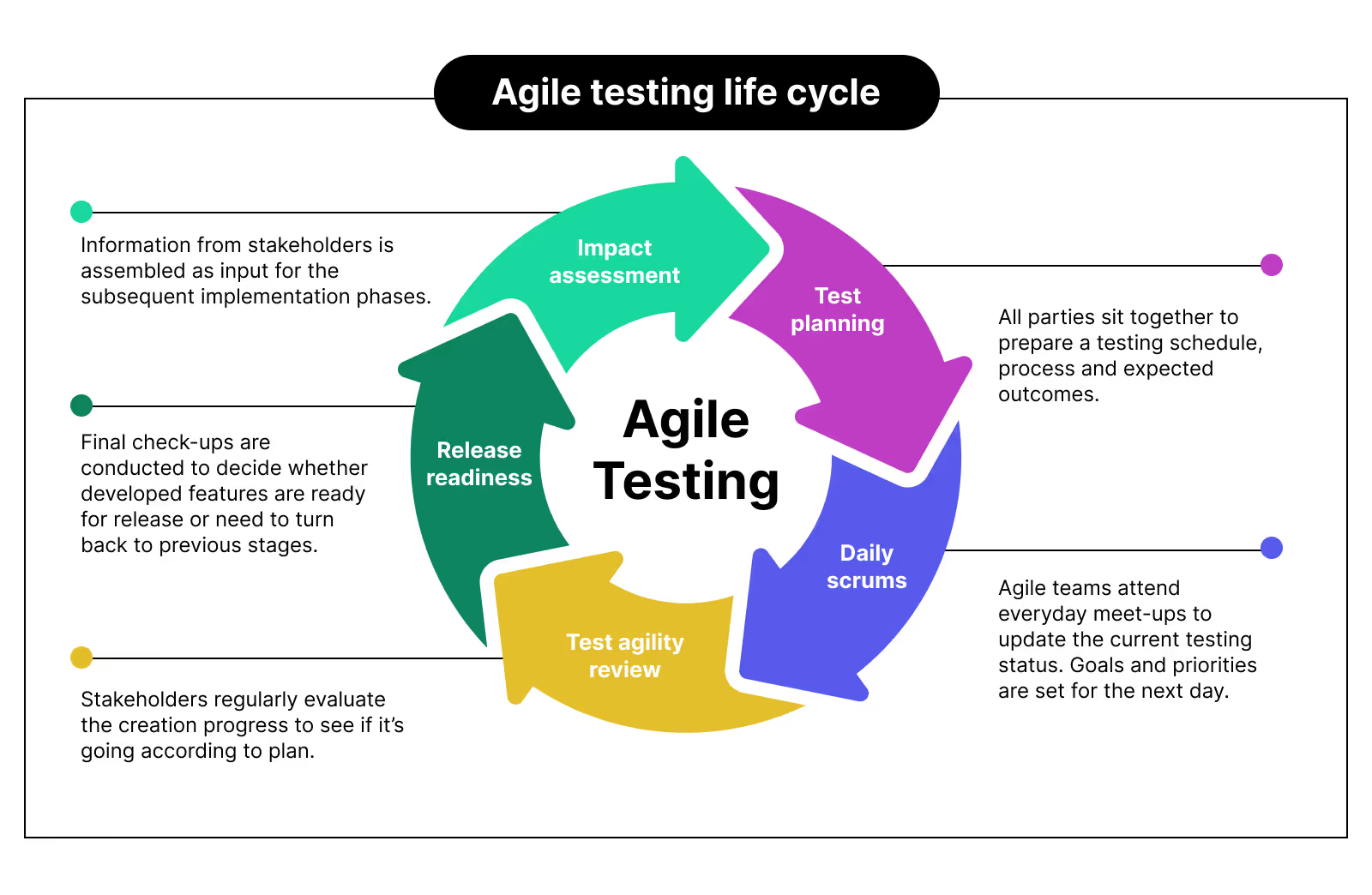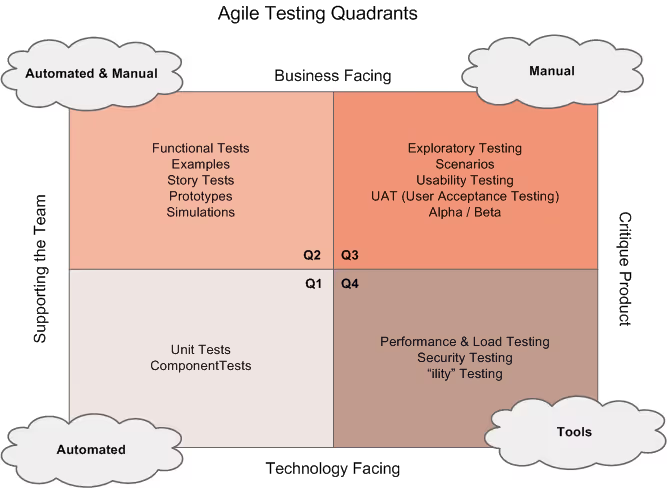It's pretty likely, at this point, that you're using some form of Agile methodology - depending on which study you read, around 60-80% of dev teams currently describe themselves as 'Agile'.
But are your testing processes as agile as your development ones?
If you're running your testing at the end of the development phase - yes, even if you're leaving it to the end of each sprint rather than the project as a whole - you're significantly hampering the adaptability, software quality, and reduced time to market that Agile can offer.
Enter the Agile Testing Life Cycle (ATLC).
Designed to align your testing processes with key Agile principles, the ATLC allows you to release quality software quicker, improve collaboration across your technical teams, and reduce overall project costs.
Here's everything you need to know.
What is the Agile Testing Life Cycle?
The Agile Testing Life Cycle is an approach to software testing designed around the principles of Agile development methodology (if you're new to Agile, you'll find these outlined in the Agile Development Manifesto).
The cycle itself consists of five basic stages:
- Test planning: stakeholders work together to build a testing schedule and approach
- Daily scrums: teams provide daily updates and set priorities for the next day
- Test agility review: stakeholders meet regularly to evaluate the process and discuss any changes needed
- Release readiness: stakeholders assess the results of the test to decide whether features are ready for release, or whether further development work is needed
- Impact assessment: stakeholders provide feedback/input for subsequent testing cycles

What's unique about the Agile Testing Life Cycle, as opposed to the Software Testing Life Cycle more generally?
In Agile, you test concurrently and continuously. The testing process isn't a large block at the end of the development phase - it runs alongside it, so that results are continuously fed back into development and that issues are caught earlier and easier to correct.
You might have heard of a similar process called 'shift left' testing - same principles. Testing early and often beats a huge testing operation right before you think you're done.
Which Agile Development Methodologies Does the ATLC Work With?
It doesn't matter if you swear by Test Driven Development, Acceptance TestDriven Development, Behavior Driven Development, or any approach - the ATLC is compatible with all Agile development methodologies. You don't have to commit to one to benefit from it.
What are the Benefits of the Agile Testing Life Cycle?
In a nutshell: it helps your team deliver quality, defect-free software more efficiently. Ultimately, this leads to better project outcomes and, thanks to improved software quality and time to market, higher user satisfaction.
1. Continuous integration leads to a faster time to market
Testing code as you develop it allows for continuous integration of fixes into central repositories, reducing time spent identifying and fixing faulty code. The potential for continuous feedback and rapid iteration allows teams to deliver market-ready products faster.
2. Testing concurrently helps you identify defects early
Testing once development work has been completed is time consuming and leads to poorer overall outcomes for your app.
Agile testing allows you to identify errors earlier on in the development process, when they are easier and cheaper to fix. This reduces the time you need to spend on testing, and as a result offers:
- Better risk management, thanks to early identification and mitigation
- Reduced project timescales and costs, due fixing defects earlier in the process
- A more robust product, due to consistent testing throughout the development process
3. Close collaboration improves overall software outcomes
It's about more than having everyone on the same page and increasing project transparency in general - though these are both great reasons to opt for Agile testing in themselves!
When you completely separate your development and testing teams, you increase the potential for technical debt. Because developers never have to test their code, they create code that's hard to test, building up a time bomb of delays for testing teams.
The Agile Testing Life Cycle minimizes by ensuring close collaboration between all stakeholders throughout the project, with daily scrums and regular test agility reviews. Your developers are involved in testing from Day 1, resulting in improved outcomes in testing and beyond.
4. Continuous testing and closer collaboration result in more adaptable testing approaches
Adaptability is one of Agile development's biggest assets. By working in short, sharp 'sprints', developers remain adaptable to changing requirements and can incorporate client feedback quickly.
The Agile Testing Life Cycle brings this adaptability to your testing processes.As customer needs evolve, or stakeholders provide feedback on the success of previous testing rounds, your team can optimize their approach to ensure all testing plans for maximum relevancy and efficiency.
5 Best Practices for the Agile Testing Life Cycle
1. Choose the Right Metrics
You can't improve anything if you don't measure it. Tracking the right metrics allows you to get areal insight into your current testing processes and help pinpoint bottlenecks, inefficiencies, and potential quality issues.
The most relevant metrics for you will depend on your project and goals - here are a few to get your started:
- Test execution coverage: the percentage of planned test cases executed within a sprint
- Defect density: the number of defects discovered during testing, relative to the size of the application
- Velocity: how much testing your team completes within a sprint
- Defect cycle time: time taken to identify and resolve defects
- Defect leakage: how many bugs slip past your testing processes into production
2. Automate Where Possible
The Agile Testing Life Cycle isn't about automating absolutely everything -it's about automating where you can to maximize test coverage and deploy manual resources where the human touch really matters. Save your manual testing teamfor in-depth UX work and exploratory testing.
Tired of writing and maintaining test automation scripts? Save even more time by using an AI low-code testing app to write tests from plain English, fix flaky tests automatically, and integrate directly into your CI/CD pipeline.
3. Integration is Continuous - Feedback Should Be As Well
Obviously, CI is what we're all shooting for. But there's another benefit of iterative, concurrent testing cycles - they offer unparalleled opportunity for feedback and optimization. Which means, theoretically, your testing processes get better the more you test!
It's easy to gloss over process improvements in favor of more results analysis during the impact assessment stage, because everyone is hyper-focused on building the best app you possibly can. Make sure to ring-fence time for feedback on the testing process itself - the takeaways will be just as valuable in the long run.
4. Prioritize Testing Based on Business Value and Complexity
Some things are more important to test than others. If something isn't quite right with, say, your main signup process, you want to give yourself as much opportunity to completely get on top of it before you go live.
Establish priority tests in the planning stage of the Agile Testing Life Cycle, and execute them as soon as you can. Anything that's business critical, particularly complex, or presents a significant risk goes at the top of the list.
You might want to use the Agile Testing Quadrant to help categorize your tests and plan the resources you'll need to dedicate to them. Each quadrant represents tests with different purposes and resource requirements:
- Quadrant 1: Technology-facing tests that support the team
- Quadrant 2: Business-facing tests that support the team
- Quadrant 3: Business-facing tests that critique the product
- Quadrant 4: Technology-facing tests that critique the product

5. Establish Strong Data Management Practices
All the usual housekeeping rules apply here (version control for data sets, regular validation checks etc) - enforce them strictly to maintain data quality and security.
Agile test data should be realistic, so that you can accurately test how your app performs under real world circumstances. If you're using data gathered from production, use masking or anonymization tools for privacy.
If your tests need more data than you currently hold - or are willing to commit to storing safely - there are a number of automated tools you can use to generate realistic test data based on predefined rules. This is great for expanding your test coverage to a wider range of cases with minimal extra time spend.
Momentic: Your Engineers' Software Testing Cheat Code?
"Momentic makes it 3x faster for our team to write and maintain end to endtests."
Alex Cui, CTO, GPTZero
We'd love to see if Momentic's AI testing tools could help you optimize your software testing life cycle.
If, like Alex and his team, you're keen to save over two thirds of the time you spend on key testing processes, why not schedule a conversation with our founder?


